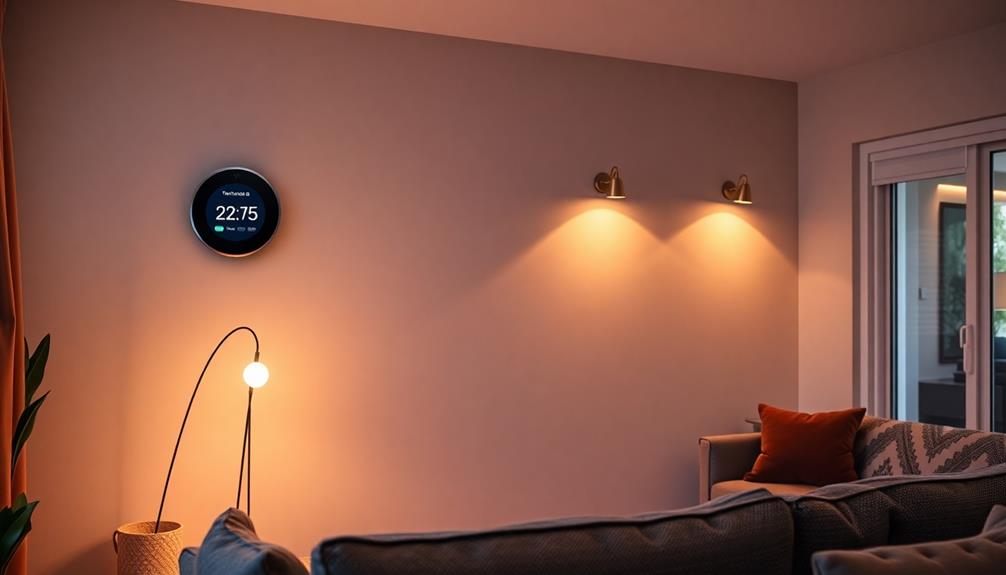Integrating your Nest Thermostat with Home Assistant transforms how you manage your home's temperature effortlessly. First, check your thermostat's compatibility and create a Nest Developer account for API credentials. Install the Nest integration component in Home Assistant, ensuring both devices are up-to-date. You can automate your thermostat to adjust based on your daily routines, like setting an "Away" mode for energy saving or cooler "Night" settings. If you hit any snags, double-check your credentials and connectivity. Mastering this setup will enhance your comfort and efficiency, and there's more to explore to optimize your experience further.
Key Takeaways
- Verify that your Nest Thermostat is compatible with Home Assistant and ensure both devices have the latest firmware updates.
- Create a Nest Developer account to obtain necessary API credentials for seamless integration.
- Install the Nest integration component in Home Assistant and check your internet connectivity for optimal performance.
- Set up automated routines based on your lifestyle, including occupancy adjustments and energy-saving modes for efficiency.
- Regularly review and customize your temperature settings to adapt to changing needs and enhance comfort in your home.
Overview of Integration

Integrating your Nest Thermostat with Home Assistant opens up a world of effortless temperature management right at your fingertips. This connection allows you to control your thermostat seamlessly, enhancing your home automation experience.
By ensuring compatibility between your Nest Thermostat and Home Assistant, you enable effective communication between the two systems, leading to improved energy efficiency and comfort. You can easily adjust temperature settings or create automated routines based on your lifestyle and preferences.
With thoughtful integration, you'll enjoy a more responsive living environment, where temperature changes occur automatically based on occupancy or time of day. This powerful combination transforms how you interact with your home, making temperature management not just convenient, but also tailored to your unique needs.
Preparation Steps

Before you can enjoy the full benefits of your Nest Thermostat integration with Home Assistant, some preparation steps are necessary.
First, verify your Nest Thermostat model is compatible with Home Assistant. Next, create a Nest Developer account to access the necessary API credentials.
After that, gather your API credentials from the Nest Developer portal. You'll also need to install the Nest integration component within Home Assistant.
Make sure to configure your Home Assistant settings properly to incorporate the Nest Thermostat. Finally, double-check your internet connection and firmware versions for both devices to guarantee peak performance.
Following these steps will set you up for a smooth integration experience and pave the way for effective home automation.
Automation Features

How can automation features elevate your Nest Thermostat experience with Home Assistant? By leveraging these features, you can create intelligent temperature adjustments based on occupancy, time of day, or even weather conditions, guaranteeing your home is always comfortable and energy-efficient.
Here's a quick comparison of automation scenarios:
| Scenario | Benefit |
|---|---|
| Home Occupied | Adjusts temperature for comfort |
| Away Mode | Saves energy by lowering temps |
| Night Mode | Guarantees a cooler, restful sleep |
| Weather Triggered | Adapts to external temperature changes |
| Scheduled Adjustments | Maintains consistent comfort levels |
These automation features not only enhance your living environment but also help you save on energy costs and increase convenience.
Control Settings

With automation features enhancing your Nest Thermostat experience, control settings play a pivotal role in ensuring your system operates efficiently.
You can customize temperature schedules based on your daily routine, making it easy to maintain comfort while saving energy. Adjust settings for different zones in your home, allowing for personalized comfort in every room.
Utilize features like Eco Mode, which automatically adjusts temperatures when you're away, or set temperature limits to prevent extreme fluctuations.
Integrating with other smart devices allows you to create cohesive routines, optimizing your home environment.
Regularly review these control settings to adapt to any changes in your lifestyle, ensuring your thermostat continues to meet your needs effectively.
Troubleshooting Tips

Troubleshooting your Nest Thermostat integration can sometimes feel challenging, but knowing common issues and solutions makes the process smoother.
First, verify your Nest Thermostat and Home Assistant are running the latest firmware. If you're experiencing connectivity problems, check your internet connection and restart both devices.
Pay attention to the API credentials you've configured; incorrect entries can prevent integration. If automations don't trigger as expected, review the conditions and triggers set in Home Assistant.
Additionally, inspect the Nest settings for compatibility issues. If you encounter persistent problems, consult the Home Assistant community forums for insights.
Best Practices

Integrating your Nest Thermostat with Home Assistant can be highly rewarding, but following best practices guarantees a seamless experience.
Here are some key tips to keep in mind:
- Keep your firmware updated: Regularly check for updates for both your Nest Thermostat and Home Assistant to guarantee optimal performance.
- Maintain a stable internet connection: A reliable network is essential for smooth communication between devices.
- Review your settings periodically: Regularly adjust your configurations based on performance to enhance efficiency.
- Prioritize security: Be aware of potential security risks and implement measures to protect your smart home ecosystem.
Future of Smart Home Integration

As smart home technology continues to evolve, the future of smart home integration looks promising and exciting.
You'll likely see even more seamless connectivity between devices, making it easier to manage your home environment. Imagine controlling your lights, thermostat, and security system all from one interface without compatibility issues.
AI-driven automation will personalize your home experience, adapting to your habits and preferences effortlessly. Enhanced data privacy measures will also empower you to feel safer while enjoying smart technology.
Plus, as energy efficiency becomes a priority, smart homes will help you reduce costs while minimizing your carbon footprint. Embracing these advancements will lead to a more convenient, comfortable, and sustainable living experience. These technologies not only make everyday tasks easier but also provide valuable insights into energy usage, allowing homeowners to make smarter decisions tailored to their needs. Whether you’re evaluating a bungalow or twostorey comparison, energy-efficient systems can be customized to suit the layout and requirements of various home designs. By integrating these solutions, you’re investing in long-term savings and contributing to a greener future.
Frequently Asked Questions
Can I Use Multiple Nest Thermostats With Home Assistant?
Yes, you can use multiple Nest thermostats with Home Assistant. Just verify each thermostat is compatible and properly configured in the system, allowing you to manage and automate temperature settings across different zones in your home.
What Are the Energy-Saving Features of the Nest Thermostat?
You'll love how the Nest Thermostat learns your habits, adjusting temperatures automatically to save energy. Its Eco mode minimizes usage when you're away, while energy reports keep you informed about your consumption habits.
How Do I Reset My Nest Thermostat After Integration?
To reset your Nest Thermostat, press the thermostat ring to open settings, navigate to "Reset," and select "All Settings." Confirm your choice, and your thermostat will restart, clearing previous configurations and settings.
Is There a Mobile App for Managing Nest With Home Assistant?
While Nest's app offers basic control, you'll find managing it through Home Assistant gives you extensive features. You can customize settings and automate adjustments, turning your smartphone into a powerful home management tool.
How Does Nest Thermostat Handle Extreme Temperature Changes?
When extreme temperature changes occur, your Nest Thermostat adjusts automatically, optimizing your home's climate. It learns from your preferences, ensuring comfort by responding quickly to fluctuations and maintaining an efficient energy balance.
Conclusion
By integrating your Nest Thermostat with Home Assistant, you're not just enhancing your home's comfort, but you're also stepping into the future of smart living. Imagine adjusting your thermostat from the couch or setting it to automatically adapt to your routine—what a game changer! With just a few simple steps, you'll gain access to convenience and efficiency. So, why wait? Immerse yourself in this seamless integration and watch your home transform into a smarter, more energy-efficient haven!









